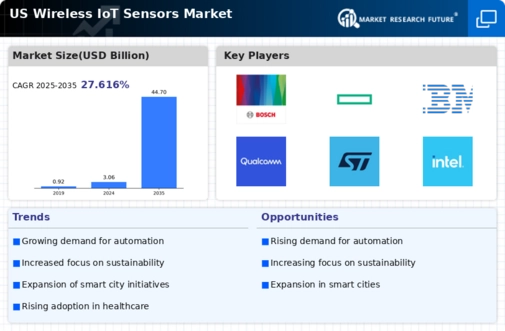Increased Investment in Smart Cities
The wireless iot-sensors market is poised for growth due to the rising investment in smart city initiatives across the US. Municipalities are increasingly adopting smart technologies to improve urban infrastructure, enhance public safety, and optimize resource management. Wireless iot-sensors play a vital role in these initiatives by providing real-time data on traffic patterns, waste management, and environmental conditions. According to estimates, investments in smart city projects in the US are expected to exceed $100 billion by 2025. This influx of funding is likely to create substantial opportunities for the wireless iot-sensors market, as cities seek to implement innovative solutions that enhance the quality of life for residents.
Growing Demand for Smart Home Solutions
The wireless iot-sensors market is experiencing a surge in demand driven by the increasing adoption of smart home technologies. Consumers are increasingly seeking solutions that enhance convenience, security, and energy efficiency within their homes. According to recent data, the smart home market in the US is projected to reach approximately $100 billion by 2025, with wireless iot-sensors playing a crucial role in this transformation. These sensors enable homeowners to monitor and control various aspects of their living environment, such as lighting, temperature, and security systems, remotely. As more households integrate smart devices, the wireless iot-sensors market is likely to expand significantly, reflecting a shift towards more connected and automated living spaces.
Advancements in Connectivity Technologies
The wireless iot-sensors market is benefiting from rapid advancements in connectivity technologies, such as 5G and LPWAN (Low Power Wide Area Network). These technologies enhance the performance and reliability of wireless sensors, enabling them to transmit data over longer distances with lower power consumption. The rollout of 5G networks across the US is expected to significantly improve the capabilities of wireless iot-sensors, allowing for more complex applications in various sectors, including smart cities and industrial automation. As connectivity improves, the market is likely to witness an influx of innovative sensor solutions, further driving growth and adoption across multiple industries.
Growing Need for Real-Time Data Analytics
The wireless iot-sensors market is significantly driven by the increasing need for real-time data analytics across various industries. Organizations are recognizing the value of data-driven decision-making and are investing in technologies that provide immediate insights into operations. Wireless iot-sensors enable the collection of vast amounts of data, which can be analyzed to improve efficiency, reduce costs, and enhance customer experiences. Industries such as manufacturing, logistics, and healthcare are particularly focused on leveraging real-time data to optimize their processes. As the demand for data analytics continues to rise, the wireless iot-sensors market is likely to expand, with projections indicating a growth rate of around 12% annually.
Rising Focus on Environmental Sustainability
The wireless iot-sensors market is increasingly influenced by the growing emphasis on environmental sustainability. Organizations and consumers alike are becoming more aware of their ecological footprints and are seeking solutions that promote energy efficiency and resource conservation. Wireless iot-sensors facilitate real-time monitoring of energy consumption, water usage, and air quality, enabling users to make informed decisions that reduce waste. The US government has set ambitious targets for reducing greenhouse gas emissions, which may further drive the adoption of these technologies. As a result, the wireless iot-sensors market is likely to see a robust increase in demand from sectors focused on sustainability initiatives, potentially leading to a market growth rate of over 15% annually.















Leave a Comment